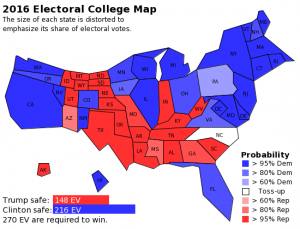Sen Bernie Sanders will join Hillary Clinton tommorrow at a Portsmouth New Hampshire high school, where he is expected to endorse her, reports John Wagner at Post Politics.
Eric Bradner of CNN Politics reports “…The party’s platform committee approved a final draft in the wee Sunday morning hours. Most notably, Clinton embraced Sanders’ call for a $15-an-hour federal minimum wage — with Sanders making the concession that it would be phased in “over time.”…And Clinton’s campaign announced her support for a “public option” — a government-run alternative to private health insurance — bringing her closer to Sanders on health care…The result: Sanders is pleased enough with the platform, three Democratic sources said, that he has committed to a joint event with Clinton Tuesday in New Hampshire and is prepared to endorse her…”We got 80% of what we wanted in this platform,” top Sanders policy adviser Warren Gunnels told CNN.” Maybe now Democratic Hillary-haters and Bernie-bashers can give it a rest and get on the victory train.
Speaking of trains, I think this one left the station some time ago, and the platform provision now seems a tad on the timid side.
At The Fix, Aaron Blake discusses a new Pew Research Center poll indicating that Trump could finish behind Libertarian Gary Johnson with 18-29 year old voters. Note to Dems: One way to reduce young voter support of Libertarians is to flush out their “free market” approach to environmental protection, which is identical to the GOP’s “solution,” and point out that only Democratic candidates support anti-pollution measures.
Yet, it looks like young voter turnout may have driven the Brexit referendum outcome, reports at The Guardian’s political editor Toby Helm.
While academics and commentators ruminate about defining white working-class voters, “More millennials identify as working class than any other generation in recent history,” notes telesurtv.net, referencing an article in Jacobin magazine. “…According to data compiled by the General Social Survey over the last 40 years, millennials identify more with working-class positions than any other group. In 2014, about 60 percent of millennials identified as such.” Although about a third of them have a college degree, “they predominantly work in service industries such as retail, hospitality, and healthcare….Highly educated millennials face problems that are typically associated with working-class living conditions: unemployment, underemployment, a precarious work life, high levels of debt, and stagnant wages.”
Speaker Paul Ryan isn’t doing so hot — even with likely Republican voters in his district, according to a recent poll. As his GOP primary opponent puts it, ““Paul Ryan is the most open borders, pro-Wall Street, anti-worker member of Congress in either party,” Paul Nehlen said during a Saturday press conference, which was held in front of Ryan’s border wall surrounding his Janesville mansion. “Everything that Americans despise about their government, Paul Ryan represents…Can you name one time when Paul Ryan fought as hard for you and your family as he’s fought for corporate America?” Nehlen asked…The Nehlen campaign notes that Ryan’s 43 percent “represents a drop of more than 30 points since the Nehlen campaign began polling likely Republican primary voters earlier in the year.”
Mark Binker argues at wral.com that “HB2 unlikely to drive voter turnout, decisions” in NC and cites views that transgender bathroom hysteria issues are a washout with voters who have strong views are already decided on which candidates and parties they arte going to support. “I think the impact of HB2 is already baked into the cake, so to speak,” says NC State poly sci proff Steve Greene, quoted in the post.
Some pretty nasty sexual harrassment allegations are mounting against Fox News creator Roger Ailes, with six new women accusers coming forward, reports David Folkenflik at NPR. But it remains unclear if Ailes will resign or settle out of court, as did Fox star Bill O’Reilly.









